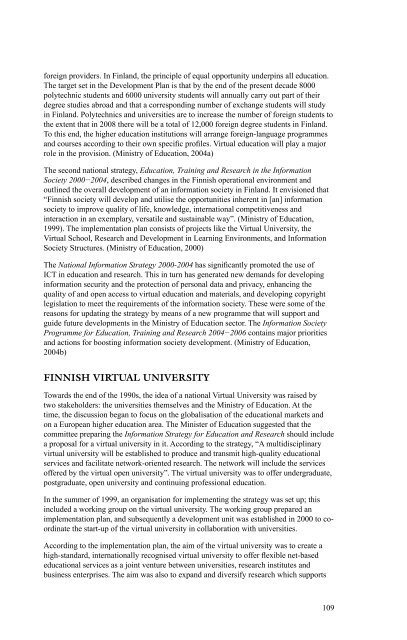lifelong learning and distance higher education - Asia Pacific Region
lifelong learning and distance higher education - Asia Pacific Region
lifelong learning and distance higher education - Asia Pacific Region
- No tags were found...
You also want an ePaper? Increase the reach of your titles
YUMPU automatically turns print PDFs into web optimized ePapers that Google loves.
foreign providers. In Finl<strong>and</strong>, the principle of equal opportunity underpins all <strong>education</strong>.The target set in the Development Plan is that by the end of the present decade 8000polytechnic students <strong>and</strong> 6000 university students will annually carry out part of theirdegree studies abroad <strong>and</strong> that a corresponding number of exchange students will studyin Finl<strong>and</strong>. Polytechnics <strong>and</strong> universities are to increase the number of foreign students tothe extent that in 2008 there will be a total of 12,000 foreign degree students in Finl<strong>and</strong>.To this end, the <strong>higher</strong> <strong>education</strong> institutions will arrange foreign-language programmes<strong>and</strong> courses according to their own specific profiles. Virtual <strong>education</strong> will play a majorrole in the provision. (Ministry of Education, 2004a)The second national strategy, Education, Training <strong>and</strong> Research in the InformationSociety 2000−2004, described changes in the Finnish operational environment <strong>and</strong>outlined the overall development of an information society in Finl<strong>and</strong>. It envisioned that“Finnish society will develop <strong>and</strong> utilise the opportunities inherent in [an] informationsociety to improve quality of life, knowledge, international competitiveness <strong>and</strong>interaction in an exemplary, versatile <strong>and</strong> sustainable way”. (Ministry of Education,1999). The implementation plan consists of projects like the Virtual University, theVirtual School, Research <strong>and</strong> Development in Learning Environments, <strong>and</strong> InformationSociety Structures. (Ministry of Education, 2000)The National Information Strategy 2000-2004 has significantly promoted the use ofICT in <strong>education</strong> <strong>and</strong> research. This in turn has generated new dem<strong>and</strong>s for developinginformation security <strong>and</strong> the protection of personal data <strong>and</strong> privacy, enhancing thequality of <strong>and</strong> open access to virtual <strong>education</strong> <strong>and</strong> materials, <strong>and</strong> developing copyrightlegislation to meet the requirements of the information society. These were some of thereasons for updating the strategy by means of a new programme that will support <strong>and</strong>guide future developments in the Ministry of Education sector. The Information SocietyProgramme for Education, Training <strong>and</strong> Research 2004−2006 contains major priorities<strong>and</strong> actions for boosting information society development. (Ministry of Education,2004b)FINNISH VIRTUAL UNIVERSITYTowards the end of the 1990s, the idea of a national Virtual University was raised bytwo stakeholders: the universities themselves <strong>and</strong> the Ministry of Education. At thetime, the discussion began to focus on the globalisation of the <strong>education</strong>al markets <strong>and</strong>on a European <strong>higher</strong> <strong>education</strong> area. The Minister of Education suggested that thecommittee preparing the Information Strategy for Education <strong>and</strong> Research should includea proposal for a virtual university in it. According to the strategy, “A multidisciplinaryvirtual university will be established to produce <strong>and</strong> transmit high-quality <strong>education</strong>alservices <strong>and</strong> facilitate network-oriented research. The network will include the servicesoffered by the virtual open university”. The virtual university was to offer undergraduate,postgraduate, open university <strong>and</strong> continuing professional <strong>education</strong>.In the summer of 1999, an organisation for implementing the strategy was set up; thisincluded a working group on the virtual university. The working group prepared animplementation plan, <strong>and</strong> subsequently a development unit was established in 2000 to coordinatethe start-up of the virtual university in collaboration with universities.According to the implementation plan, the aim of the virtual university was to create ahigh-st<strong>and</strong>ard, internationally recognised virtual university to offer flexible net-based<strong>education</strong>al services as a joint venture between universities, research institutes <strong>and</strong>business enterprises. The aim was also to exp<strong>and</strong> <strong>and</strong> diversify research which supports109
















